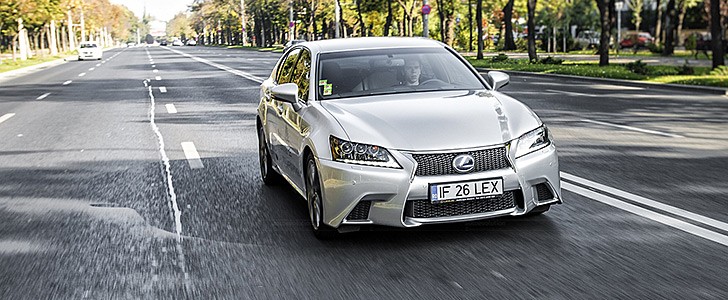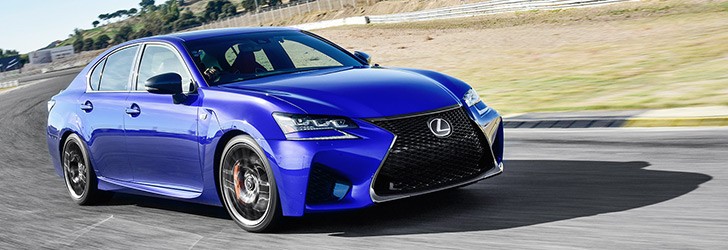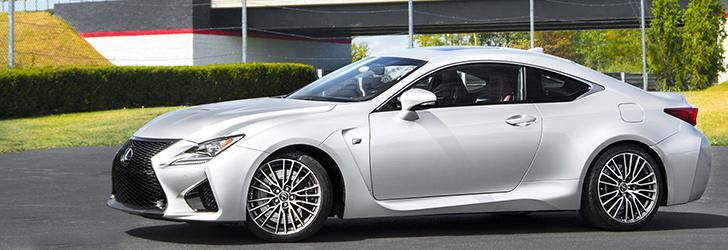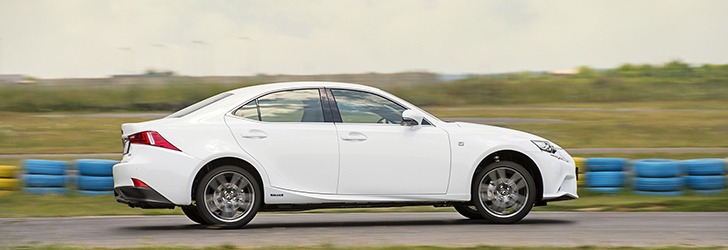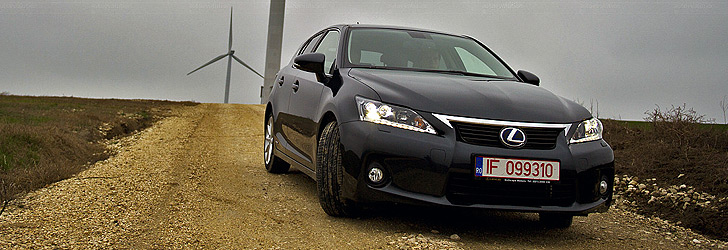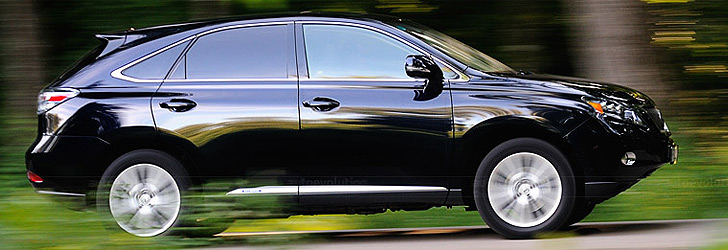LEXUS GS 450h Review
OUR TEST CAR: LEXUS GS 450h F Sport 2013
Comfort is an area where the GS shines, with the vehicle combining a multitude of elements in order to achieve this. When the new generation was designed, interior space was a top priority and this can be felt by both front and rear seat occupants. From the door openings through the cabin space and to the luggage compartment access, everything is there to make it easier for you.
From the moment you see the seats, you know that they're going to be a valuable asset and once you climb aboard you're convinced of this.
The soundproofing is top-class and if we add the interior styling, which offers a feeling of protection, we end up with a feeling that encourages you to use the car for long trips. The only thing that partially disturbs the silence is the E-CVT transmission, which can keep the V6 engine at relatively high revs, generating a bit of unwanted noise.
One interesting element is the bamboo trimming. This may bring more of a psychological advantage than a physical one, but it certainly adds bonus points for this chapter.
The multitude of gadgets also helps the GS keeps the people inside of it happy, even though some of these could use a superior implementation. The best example of this is the impressive 12.3-inch display, which uses graphics that leave many things to be desired.
In the end, the GS knows its way around providing comfort and even in the edgier F Sport trim it proves to be excellent at this game.
The GS 450h is motivated by Lexus's second-generation Hybrid Drive System. This matches a 3.5-liter V6 with an electric engine. The two units can work separately or together and in the latter case they provide an all-wheel drive setup – the electric motor feeds the front axle, while the petrol one sends its power to the rear one.
The driver has 345 hp at his disposal, while fuel efficiency has increased by 23 percent compared to the previous model, with Lexus promising an average value of 5.9 liters / 100 km. The GS 450h comes with a combined EPA rating of 31 mpg that tops that of the GS350, which offers 23 mpg. During our test drive, the GS 450h F Sport asked for 8.2 liters of fuel for every 100 km (28.7 mpg).
This is mainly owed to the fact that the internal combustion part of the car's hybrid powertrain has learned quite a lot of new tricks. First of all, it uses the Atkinson cycle, which may make the power band narrower, but increases efficiency.
The unit, which comes with a high compression ratio (13:1), features a mid-port intake tumble generator, as well as the D-4S direct injection. The latter combines the advantages of direct and indirect injection, using one injector in the combustion chamber and a second one in the intake port.
The D-4S system of this engine comes with new injectors that use an upgraded architecture and work at a higher pressure. These also offer idle port injection, which reduces the NVH level of the unit.
The rest of the powertrain has also been upgraded - The Power Control Unit (PCU), which now uses dual cooling paths, limits motor drive voltage to 500V in the ECO mode, while allowing this to climb to 650V in Sport S mode.
As for the electric motor, this comes with less internal friction and lighter mounts. In addition to that, the regenerative braking system now has a wider range, while the battery uses a new stacked layout that dramatically increases the boot space.
The new GS is 14 percent more rigid compared to the one it replaces and this comes thanks to a multitude of developments. The underbody, as well as the front and rear suspension were designed with this goal in mind, while the laser or increased spot welding has boosted the rigidity for the rear underbody and door surround areas, as well as for the entire rear area of the car. The cowl panel, underbody and rear area of the vehicle have also received thicker sheet metal of additional strengthening.
The suspension of the GS features an aluminum double wishbone setup for the front wheels, while the rear ones use a multi-link layout with toe control bars. The springs and the dampers have been separated, in order to offer superior control, as well as increase luggage capacity.
The Adaptive Variable Suspension (AVS) allows the driver to choose between two settings, a normal and a sportier one, with the latter arriving only in the Sport Plus setting of the vehicle.
The AVS continuously adjusts the damping characteristics, while in the Sport S+ mode it also creates a 10 percent difference between the inner and the outer dampers, aiming to reduce body roll.
The F Sport models use custom shock absorber tuning, as well as low-viscosity oil that minimizes friction. What's more, the rear dampers have been inclined to the rear, while the lower bushings are now stiffer and larger.
Another ace up the F Sport models' sleeve is the Lexus Dynamic Handling (LDH) system, which offers four-wheel steering. The system combines Dynamic Rear Steering (DRS) with Variable Gear Ratio Steering (VGRS) and Electric Power Steering (EPS).
LDH keeps an eye on the vehicle speed, yaw rate, lateral G forces, steering speed and angle, in order to figure out how much rear steering angle should be applied. We have to mention that the maximum angle is 2 degrees. Below 80 km/h (mph), the front and rear wheels turn in opposite directions, while past this speed all four wheels turn in the same directions when this is necessary.
In the sharpest setting of the car, Sport S+, the steering gear ratio drops by 10 percent, while the steering torque assist in increased by 4 percent.
The F Sport badges also mean that the braking system uses larger front discs, which measure 356 x 30 mm. To reduce unsprung weight and increase fading resistance, engineers have used an aluminum construction for the hat section of the two-part rotor. The GS450h uses Electronically Controlled Braking, which recovers kinetic energy, turning it into electrical current, while also aiming to offer a natural pedal feel.
The standard GS450h offers a comprehensive list of features that targets the passengers just as much as the driver.
The upholstery may use a textile material, but the front seats are 10-way power adjustable, with a memory feature for the driver. They’re also heated and offering 2-way lumbar support.
The person in the driver’s seat can enjoy an electric adjustable steering column, gearshift paddles for the dedicated mode of the powertrain, a leather-wrapped steering wheel, as well as automatic electrochromic mirrors.
As for the aforementioned attention for passengers, this is shown with the help of a 12-speaker audio system, which offers features such as DAB digital radio, a DVD player, as well as an USB port, Bluetooth capability and an auxiliary in connection. This can also be controlled using the multifunctional steering wheel.
The navigation package of the car features an 8-inch LCD display, which is also used to show the vehicle’s various climate control, audio and on-board computer parameters. This also works with the rear-view camera of the car and stores the info on a HDD. The F Sport package upgrades the display to 12.3 inches.
As far as the convenience features are concerned, the car comes with light and rain sensors, as well as all-round parking sensors and non-active cruise control.
The F Sport Package brings a comprehensive list of upgrades that target all the areas of the car, including the exterior, interior, as well as its tech side and gadgets.
Apart from the extra goodies it brings for the body and cabin of the car, this seriously upgrades the infotainment area, as it brings a Mark Levinson Premium Surround system, which works with a 12.3-inch display and relies on 17 speakers to bring the vibes inside the car.
It also ticks the safety box, thanks to a blind spot monitoring system, as well as the convenience one, through the card key it includes.
On the GS450h, the F Sport package also brings the Lexus Dynamic Handling feature. This makes quite a big difference in terms of handling, as we are talking about variable, four-wheel steering.
The 2013 Lexus GS was evaluated by the IIHS (Insurance Institute for Highway Safety) and the vehicle received a “Good” overall rating, the highest one available. The actual tests were conducted by Toyota as part of a crash test verification, with the Institute offering the ratings based on these.
During the frontal impact test, a moderate overlap one, the dummy movements was kept under control, but its head hit the roof rail during the rebound phase. This didn’t affect the rating as the acceleration resulting from the impact was low.
The side impact test results showed a low risk of significant injuries for the driver and the same was true for the rear passenger, with one exception. We’re referring to the head protection, as the dummy’s head went past the side curtain airbag and was hit by the window sill. No high head injury measures resulted from this, but the car received an “Adequate” head protection rating for the rear passenger. Nevertheless, the overall rating for the side impact is “Good”.
The tests also included a roof strength one, where a metal plate is pressed against one corner of the car’s roof. The GS also received a “Good” rating here, with its strength-to-weight ration being situated close to the class average.
To achieve the aforementioned ratings, engineers fitted the GS with an array of safety features and we’ll start with the ones you don’t want to use. The car’s passive safety systems include 10 airbags, two frontal ones, individual seat-mounted ones for front and rear occupants, side curtain airbags, as well as knee airbags for the driver and front passenger.
In addition to that, the front seats use a Whiplash Injury Lessening (WIL) feature that limits space between the headrest and the head of the occupant, aiming to reduce the whiplash injuries.
The active safety front is led by multiple optional features, starting with the per-collision one. This relies on the dynamic cruise control’s radar to monitor the road ahead and warns the driver in the even of an imminent collision. It also uses an infrared camera that monitors the driver’s eyes. If the system detects an imminent collision and the driver doesn’t seem to be looking ahead, it will send an early warning. Should the driver not respond, the system can apply light braking pressure up to two seconds before the crash.
The list of available active safety features includes Lane Departure Warning and Lane Keep Assist, which can use light steering inputs to keep the car in its lane, a Head Up Display, a Night Vision System, as well as a Blind Spot Monitor.
Lexus has taken the GS closer to its German competitors with this new generation and this is a car that perfectly illustrates the company's "no diesel, but hybrids" approach.
The F Sport badges brings quite a lot to the GS, targeting the exterior, the cabin, as well as the tech side of the car. Basically, you receive a more focused proposal, but the high level of comfort is still there.
Don't imagine that you'll get the most dynamic performer in the lot though, this is more of a luxury saloon with a few sporting abilities.
This model receives a few dedicated styling tricks and, even though you may not be able to put your finger on them from the first moment, they take the already sharp appearance of the vehicle even further.
It's the same story inside the GS where the F Sport elements make the GS look like a driver's car without affecting the coziness.
Speaking of the interior, this generates mixed feelings and emotions, as it combines futuristic features, such as as a 12.3-inch display, with features that feel outdated, like certain plastics, or the implementation of the Head-Up Display.
The list of technical changes is short but includes complex modifications, such as the all-wheel steering and a Sport Plus driving mode. This offers a firmer setup for the suspension, as well as better response for the steering, two assets the car really needs.
If the showroom you’re acquiring your GS from happens to be in the US, you won’t be able to fit a GS450h with an F Sport package. Here, the GS450h comes with a MSRP of $59,450, plus a processing and handling fee of $895. European buyers can acquire a GS450h for €61,400, while the F Sport model we drove will set you back €75,700 - both prices include 19 percent VAT.
Each and every aspect of the GS has been seriously enhanced and, taken in isolation, this is a proper luxury sedan. It's an interesting proposal, but when you compare it to its German rivals you can't find too many scenarios in which you'd choose it.
The GS 450h F Sport must have the most aggressive front fascia of any car that can be found in a dealership today and the rest of the exterior design plays along nicely.
Nevertheless, you shouldn't be fooled by the visual muscles of our test car, the best part of it is the comfort it offers. This can be felt in any situation, regardless of the trip's length.
Alas, the aggressive styling cues are also the ones that make you expect a matching firepower and this, unfortunately, is not the case - we'll file this under "the worst part of the car".
The GS 450h F Sport is the range-topping model but it can't deliver proper performance. While the straight line act is decent, the soft suspension and the lack of steering feel make the handling almost disappointing when you're driving fast.
Put away most of the sporty driving plans and then you'll be able to use the abilities of the GS 450h F Sport.
From the moment you see the seats, you know that they're going to be a valuable asset and once you climb aboard you're convinced of this.
The soundproofing is top-class and if we add the interior styling, which offers a feeling of protection, we end up with a feeling that encourages you to use the car for long trips. The only thing that partially disturbs the silence is the E-CVT transmission, which can keep the V6 engine at relatively high revs, generating a bit of unwanted noise.
One interesting element is the bamboo trimming. This may bring more of a psychological advantage than a physical one, but it certainly adds bonus points for this chapter.
The multitude of gadgets also helps the GS keeps the people inside of it happy, even though some of these could use a superior implementation. The best example of this is the impressive 12.3-inch display, which uses graphics that leave many things to be desired.
In the end, the GS knows its way around providing comfort and even in the edgier F Sport trim it proves to be excellent at this game.
The GS 450h is motivated by Lexus's second-generation Hybrid Drive System. This matches a 3.5-liter V6 with an electric engine. The two units can work separately or together and in the latter case they provide an all-wheel drive setup – the electric motor feeds the front axle, while the petrol one sends its power to the rear one.
The driver has 345 hp at his disposal, while fuel efficiency has increased by 23 percent compared to the previous model, with Lexus promising an average value of 5.9 liters / 100 km. The GS 450h comes with a combined EPA rating of 31 mpg that tops that of the GS350, which offers 23 mpg. During our test drive, the GS 450h F Sport asked for 8.2 liters of fuel for every 100 km (28.7 mpg).
This is mainly owed to the fact that the internal combustion part of the car's hybrid powertrain has learned quite a lot of new tricks. First of all, it uses the Atkinson cycle, which may make the power band narrower, but increases efficiency.
The unit, which comes with a high compression ratio (13:1), features a mid-port intake tumble generator, as well as the D-4S direct injection. The latter combines the advantages of direct and indirect injection, using one injector in the combustion chamber and a second one in the intake port.
The D-4S system of this engine comes with new injectors that use an upgraded architecture and work at a higher pressure. These also offer idle port injection, which reduces the NVH level of the unit.
The rest of the powertrain has also been upgraded - The Power Control Unit (PCU), which now uses dual cooling paths, limits motor drive voltage to 500V in the ECO mode, while allowing this to climb to 650V in Sport S mode.
As for the electric motor, this comes with less internal friction and lighter mounts. In addition to that, the regenerative braking system now has a wider range, while the battery uses a new stacked layout that dramatically increases the boot space.
The new GS is 14 percent more rigid compared to the one it replaces and this comes thanks to a multitude of developments. The underbody, as well as the front and rear suspension were designed with this goal in mind, while the laser or increased spot welding has boosted the rigidity for the rear underbody and door surround areas, as well as for the entire rear area of the car. The cowl panel, underbody and rear area of the vehicle have also received thicker sheet metal of additional strengthening.
The suspension of the GS features an aluminum double wishbone setup for the front wheels, while the rear ones use a multi-link layout with toe control bars. The springs and the dampers have been separated, in order to offer superior control, as well as increase luggage capacity.
The Adaptive Variable Suspension (AVS) allows the driver to choose between two settings, a normal and a sportier one, with the latter arriving only in the Sport Plus setting of the vehicle.
The AVS continuously adjusts the damping characteristics, while in the Sport S+ mode it also creates a 10 percent difference between the inner and the outer dampers, aiming to reduce body roll.
The F Sport models use custom shock absorber tuning, as well as low-viscosity oil that minimizes friction. What's more, the rear dampers have been inclined to the rear, while the lower bushings are now stiffer and larger.
Another ace up the F Sport models' sleeve is the Lexus Dynamic Handling (LDH) system, which offers four-wheel steering. The system combines Dynamic Rear Steering (DRS) with Variable Gear Ratio Steering (VGRS) and Electric Power Steering (EPS).
LDH keeps an eye on the vehicle speed, yaw rate, lateral G forces, steering speed and angle, in order to figure out how much rear steering angle should be applied. We have to mention that the maximum angle is 2 degrees. Below 80 km/h (mph), the front and rear wheels turn in opposite directions, while past this speed all four wheels turn in the same directions when this is necessary.
In the sharpest setting of the car, Sport S+, the steering gear ratio drops by 10 percent, while the steering torque assist in increased by 4 percent.
The F Sport badges also mean that the braking system uses larger front discs, which measure 356 x 30 mm. To reduce unsprung weight and increase fading resistance, engineers have used an aluminum construction for the hat section of the two-part rotor. The GS450h uses Electronically Controlled Braking, which recovers kinetic energy, turning it into electrical current, while also aiming to offer a natural pedal feel.
The standard GS450h offers a comprehensive list of features that targets the passengers just as much as the driver.
The upholstery may use a textile material, but the front seats are 10-way power adjustable, with a memory feature for the driver. They’re also heated and offering 2-way lumbar support.
The person in the driver’s seat can enjoy an electric adjustable steering column, gearshift paddles for the dedicated mode of the powertrain, a leather-wrapped steering wheel, as well as automatic electrochromic mirrors.
As for the aforementioned attention for passengers, this is shown with the help of a 12-speaker audio system, which offers features such as DAB digital radio, a DVD player, as well as an USB port, Bluetooth capability and an auxiliary in connection. This can also be controlled using the multifunctional steering wheel.
The navigation package of the car features an 8-inch LCD display, which is also used to show the vehicle’s various climate control, audio and on-board computer parameters. This also works with the rear-view camera of the car and stores the info on a HDD. The F Sport package upgrades the display to 12.3 inches.
As far as the convenience features are concerned, the car comes with light and rain sensors, as well as all-round parking sensors and non-active cruise control.
The F Sport Package brings a comprehensive list of upgrades that target all the areas of the car, including the exterior, interior, as well as its tech side and gadgets.
Apart from the extra goodies it brings for the body and cabin of the car, this seriously upgrades the infotainment area, as it brings a Mark Levinson Premium Surround system, which works with a 12.3-inch display and relies on 17 speakers to bring the vibes inside the car.
It also ticks the safety box, thanks to a blind spot monitoring system, as well as the convenience one, through the card key it includes.
On the GS450h, the F Sport package also brings the Lexus Dynamic Handling feature. This makes quite a big difference in terms of handling, as we are talking about variable, four-wheel steering.
The 2013 Lexus GS was evaluated by the IIHS (Insurance Institute for Highway Safety) and the vehicle received a “Good” overall rating, the highest one available. The actual tests were conducted by Toyota as part of a crash test verification, with the Institute offering the ratings based on these.
During the frontal impact test, a moderate overlap one, the dummy movements was kept under control, but its head hit the roof rail during the rebound phase. This didn’t affect the rating as the acceleration resulting from the impact was low.
The side impact test results showed a low risk of significant injuries for the driver and the same was true for the rear passenger, with one exception. We’re referring to the head protection, as the dummy’s head went past the side curtain airbag and was hit by the window sill. No high head injury measures resulted from this, but the car received an “Adequate” head protection rating for the rear passenger. Nevertheless, the overall rating for the side impact is “Good”.
The tests also included a roof strength one, where a metal plate is pressed against one corner of the car’s roof. The GS also received a “Good” rating here, with its strength-to-weight ration being situated close to the class average.
To achieve the aforementioned ratings, engineers fitted the GS with an array of safety features and we’ll start with the ones you don’t want to use. The car’s passive safety systems include 10 airbags, two frontal ones, individual seat-mounted ones for front and rear occupants, side curtain airbags, as well as knee airbags for the driver and front passenger.
In addition to that, the front seats use a Whiplash Injury Lessening (WIL) feature that limits space between the headrest and the head of the occupant, aiming to reduce the whiplash injuries.
The active safety front is led by multiple optional features, starting with the per-collision one. This relies on the dynamic cruise control’s radar to monitor the road ahead and warns the driver in the even of an imminent collision. It also uses an infrared camera that monitors the driver’s eyes. If the system detects an imminent collision and the driver doesn’t seem to be looking ahead, it will send an early warning. Should the driver not respond, the system can apply light braking pressure up to two seconds before the crash.
The list of available active safety features includes Lane Departure Warning and Lane Keep Assist, which can use light steering inputs to keep the car in its lane, a Head Up Display, a Night Vision System, as well as a Blind Spot Monitor.
Lexus has taken the GS closer to its German competitors with this new generation and this is a car that perfectly illustrates the company's "no diesel, but hybrids" approach.
The F Sport badges brings quite a lot to the GS, targeting the exterior, the cabin, as well as the tech side of the car. Basically, you receive a more focused proposal, but the high level of comfort is still there.
Don't imagine that you'll get the most dynamic performer in the lot though, this is more of a luxury saloon with a few sporting abilities.
This model receives a few dedicated styling tricks and, even though you may not be able to put your finger on them from the first moment, they take the already sharp appearance of the vehicle even further.
It's the same story inside the GS where the F Sport elements make the GS look like a driver's car without affecting the coziness.
Speaking of the interior, this generates mixed feelings and emotions, as it combines futuristic features, such as as a 12.3-inch display, with features that feel outdated, like certain plastics, or the implementation of the Head-Up Display.
The list of technical changes is short but includes complex modifications, such as the all-wheel steering and a Sport Plus driving mode. This offers a firmer setup for the suspension, as well as better response for the steering, two assets the car really needs.
If the showroom you’re acquiring your GS from happens to be in the US, you won’t be able to fit a GS450h with an F Sport package. Here, the GS450h comes with a MSRP of $59,450, plus a processing and handling fee of $895. European buyers can acquire a GS450h for €61,400, while the F Sport model we drove will set you back €75,700 - both prices include 19 percent VAT.
Each and every aspect of the GS has been seriously enhanced and, taken in isolation, this is a proper luxury sedan. It's an interesting proposal, but when you compare it to its German rivals you can't find too many scenarios in which you'd choose it.
The GS 450h F Sport must have the most aggressive front fascia of any car that can be found in a dealership today and the rest of the exterior design plays along nicely.
Nevertheless, you shouldn't be fooled by the visual muscles of our test car, the best part of it is the comfort it offers. This can be felt in any situation, regardless of the trip's length.
Alas, the aggressive styling cues are also the ones that make you expect a matching firepower and this, unfortunately, is not the case - we'll file this under "the worst part of the car".
The GS 450h F Sport is the range-topping model but it can't deliver proper performance. While the straight line act is decent, the soft suspension and the lack of steering feel make the handling almost disappointing when you're driving fast.
Put away most of the sporty driving plans and then you'll be able to use the abilities of the GS 450h F Sport.
THE END
12
Our LEXUS Testdrives:
Photo gallery (85)
